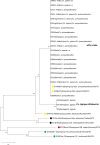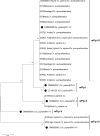Screening of natural Wolbachia infection in mosquitoes (Diptera: Culicidae) from the Cape Verde islands
- PMID: 37098535
- PMCID: PMC10131387
- DOI: 10.1186/s13071-023-05745-w
Screening of natural Wolbachia infection in mosquitoes (Diptera: Culicidae) from the Cape Verde islands
Abstract
Background: Wolbachia pipientis is an endosymbiont bacterium that induces cytoplasmic incompatibility and inhibits arboviral replication in mosquitoes. This study aimed to assess Wolbachia prevalence and genetic diversity in different mosquito species from Cape Verde.
Methods: Mosquitoes were collected on six islands of Cape Verde and identified to species using morphological keys and PCR-based assays. Wolbachia was detected by amplifying a fragment of the surface protein gene (wsp). Multilocus sequence typing (MLST) was performed with five housekeeping genes (coxA, gatB, ftsZ, hcpA, and fbpA) and the wsp hypervariable region (HVR) for strain identification. Identification of wPip groups (wPip-I to wPip-V) was performed using PCR-restriction fragment length polymorphism (RFLP) assay on the ankyrin domain gene pk1.
Results: Nine mosquito species were collected, including the major vectors Aedes aegypti, Anopheles arabiensis, Culex pipiens sensu stricto, and Culex quinquefasciatus. Wolbachia was only detected in Cx. pipiens s.s. (100% prevalence), Cx. quinquefasciatus (98.3%), Cx. pipiens/quinquefasciatus hybrids (100%), and Culex tigripes (100%). Based on the results of MLST and wsp hypervariable region typing, Wolbachia from the Cx. pipiens complex was assigned to sequence type 9, wPip clade, and supergroup B. PCR/RFLP analysis revealed three wPip groups in Cape Verde, namely wPip-II, wPip-III, and wPip-IV. wPip-IV was the most prevalent, while wPip-II and wPip-III were found only on Maio and Fogo islands. Wolbachia detected in Cx. tigripes belongs to supergroup B, with no attributed MLST profile, indicating a new strain of Wolbachia in this mosquito species.
Conclusions: A high prevalence and diversity of Wolbachia was found in species from the Cx. pipiens complex. This diversity may be related to the mosquito's colonization history on the Cape Verde islands. To the best of our knowledge, this is the first study to detect Wolbachia in Cx. tigripes, which may provide an additional opportunity for biocontrol initiatives.
Keywords: Cape Verde; Culex pipiens; Culex tigripes; Genotyping; Mosquitoes; Wolbachia.
© 2023. The Author(s).
Conflict of interest statement
The authors declare that they have no competing interests.
Figures



Similar articles
-
Wolbachia in mosquitoes from the Central Valley of California, USA.Parasit Vectors. 2020 Nov 10;13(1):558. doi: 10.1186/s13071-020-04429-z. Parasit Vectors. 2020. PMID: 33168082 Free PMC article.
-
Wolbachia diversity and cytoplasmic incompatibility patterns in Culex pipiens populations in Turkey.Parasit Vectors. 2018 Mar 20;11(1):198. doi: 10.1186/s13071-018-2777-9. Parasit Vectors. 2018. PMID: 29558974 Free PMC article.
-
Molecular detection of Wolbachia pipientis in natural populations of mosquito vectors of Dirofilaria immitis from continental Portugal: first detection in Culex theileri.Med Vet Entomol. 2016 Sep;30(3):301-9. doi: 10.1111/mve.12179. Epub 2016 Jun 9. Med Vet Entomol. 2016. PMID: 27279553
-
[Molecular detection and phylogenetic analysis of Wolbachia infection in common mosquito species in Henan Province].Zhongguo Xue Xi Chong Bing Fang Zhi Za Zhi. 2023 Sep 25;35(4):389-393. doi: 10.16250/j.32.1374.2023033. Zhongguo Xue Xi Chong Bing Fang Zhi Za Zhi. 2023. PMID: 37926475 Chinese.
-
Breast cancer in Cape Verde: a 24-year retrospective study of clinical presentation, treatment and outcomes at Agostinho Neto University Hospital.Ecancermedicalscience. 2025 Jan 16;19:1826. doi: 10.3332/ecancer.2025.1826. eCollection 2025. Ecancermedicalscience. 2025. PMID: 40177147 Free PMC article. Review.
Cited by
-
Vector competence of Culex quinquefasciatus from Santiago Island, Cape Verde, to West Nile Virus: exploring the potential effect of the vector native Wolbachia.Parasit Vectors. 2024 Dec 23;17(1):536. doi: 10.1186/s13071-024-06609-7. Parasit Vectors. 2024. PMID: 39716303 Free PMC article.
-
Culex-Transmitted Diseases: Mechanisms, Impact, and Future Control Strategies using Wolbachia.Viruses. 2024 Jul 15;16(7):1134. doi: 10.3390/v16071134. Viruses. 2024. PMID: 39066296 Free PMC article. Review.
-
The Perpetual Vector Mosquito Threat and Its Eco-Friendly Nemeses.Biology (Basel). 2024 Mar 12;13(3):182. doi: 10.3390/biology13030182. Biology (Basel). 2024. PMID: 38534451 Free PMC article. Review.
-
Diversity of Wolbachia infections in Sri Lankan mosquitoes with a new record of Wolbachia Supergroup B infecting Aedes aegypti vector populations.Sci Rep. 2024 May 25;14(1):11966. doi: 10.1038/s41598-024-62476-3. Sci Rep. 2024. PMID: 38796552 Free PMC article.
-
Genome-wide detection of Wolbachia in natural Aedes aegypti populations using ddRAD-Seq.Front Cell Infect Microbiol. 2023 Dec 14;13:1252656. doi: 10.3389/fcimb.2023.1252656. eCollection 2023. Front Cell Infect Microbiol. 2023. PMID: 38162582 Free PMC article.
References
MeSH terms
Grants and funding
LinkOut - more resources
Full Text Sources
Medical

